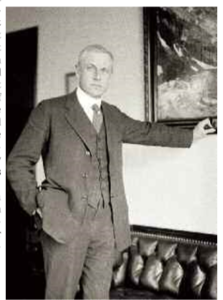by Leah S. Glaser
(c) Connecticut Explored WINTER 2016/17
Subscribe/Buy the Issue!
In 1872 Congress established Yellowstone, the first national park, “for the benefit and enjoyment of the people.” In 1891 Congress set aside forest reserves for a very different purpose: to clear and provide timber for western agrarian settlement. These actions helped define public land use and natural resource management policies for the American West.
 Several Connecticans and graduates of the Yale School of Forestry were prominently involved in these early days of forest reserves and national parks and, in turn, influenced Connecticut’s land management. They brought to the work a New England brand of conservation, as historian Richard Judd observed in his 1997 book Common Lands, Common People: The Origins of Conservation in Northern New England that fused agrarianism with “newer Romantic, urban-based visions of the forest.”
Several Connecticans and graduates of the Yale School of Forestry were prominently involved in these early days of forest reserves and national parks and, in turn, influenced Connecticut’s land management. They brought to the work a New England brand of conservation, as historian Richard Judd observed in his 1997 book Common Lands, Common People: The Origins of Conservation in Northern New England that fused agrarianism with “newer Romantic, urban-based visions of the forest.”
Along with President Theodore Roosevelt, Simsbury-born Gifford Pinchot promoted a philosophy that advocated the development of natural resources, known as conservation (as opposed to preservation). Pinchot co-founded the Yale School of Forestry in 1900 to train the nation’s first professional foresters. As a leader in the national conservation movement, Pinchot became that new United States Forest Service’s first director in 1905.
Then a 1913 plan to dam the Hetch-Hetchy Valley in Yosemite National Park to supply San Francisco with water pitted environmental conservationists like Pinchot against environmental preservationists like his friend, Sierra Club’s founder John Muir. Now neither the public nor congress trusted the forest service to protect cherished sites of beauty. Congress established the National Park Service (NPS) in 1916 to protect exceptional lands for “public enjoyment.” Stephen Mather of Darien, Connecticut, served as the agency’s first director.

Stephen Mather, first National Park Service director, c. 1910 – 1920. photo: Harris & Ewing Inc., Library of Congress
Furious, both Pinchot and his successor (and co-founder of the Yale School of Forestry), Henry Graves of Marietta, Ohio, insisted that creating a park agency was “no more needed than two tails to a cat.” Rather, Graves attested that recreation was compatible with uses such as timber clearing, mining, and grazing in the national forests. He increased recreational opportunities in the forests and at the same time worked with Mather to adopt forest management techniques in the trees within park boundaries.
Meanwhile, the graduates of the Yale School of Forestry influenced national land policies. Novice Austin Hawes, Connecticut’s state forester from 1904 to 1908 and 1921 to 1943, served in Arizona in Pinchot’s Student Assistant program. He returned to Connecticut with the belief that no one without the proper training could manage the public forests to produce quality lumber for industrial products. He observed, “Pinchot intends businesslike management of the reserves, and after seeing what I did this summer …, I think the change will be a big thing for the West.” Hawes lamented that in the East, “We have no reserves of large timber.”
Since 1895 a group of influential private citizens and Yale-educated foresters named the Connecticut Forest Association (now Connecticut Forest & Park Association) had advocated for forest legislation in a state where, unlike in the West, most of the forestland was in private hands. However, municipal parks were so popular that Connecticut created a state park commission three years before the establishment of the National Park Service. The commission’s first field secretary,Yale alumnus Albert Turner of Litchfield, echoed others, writing that “the [Connecticut] Act of 1913 repeatedly enumerates the purposes of recreation, preservation of natural beauty, or historic association, … But due to the lack of public lands, he lamented, “… the state park remains an idea only.” The first state park to open was Hammonasset Beach State Park, in 1920. Forestry gained more state support during the Great Depression, when the state focused heavily on protecting natural resources for economic development. By October 1940 80,000 acres of state forests had been set aside.
 But as increased automobile travel raised demand for local leisure opportunities, a group of businessmen, inspired by trips to the national parks in the West, focused on developing both forests and parks for recreational use alone. By the end of World War II, these recreation advocates wrested political control over the state’s park and forest commission from the Yale-trained foresters, who had spent years advocating that forests be used for multiple purposes.
But as increased automobile travel raised demand for local leisure opportunities, a group of businessmen, inspired by trips to the national parks in the West, focused on developing both forests and parks for recreational use alone. By the end of World War II, these recreation advocates wrested political control over the state’s park and forest commission from the Yale-trained foresters, who had spent years advocating that forests be used for multiple purposes.
Not surprisingly, the public today sees little difference between public forests and public parks, viewing both solely as recreational resources. This narrow understanding limits the possibilities for sustainable conservation. In this era of climate change controversy and economic hardship, we should remember the role of our state’s conservationists in advocating multiple-use policies, natural resource protection, and economic development on our public lands, both in the West and in Connecticut.
Leah S. Glaser is an associate professor of history at Central Connecticut State University, where she teaches courses about the American West.
Explore!
Yale School of Forestry
Established in 1900 in O.C. Marsh’s former home (now Marsh Hall) and grounds.
Marsh Botanical Garden, 265 Mansfield Street, New Haven
marshbotanicalgarden.yale.edu/visit
Stephen T. Mather House, 19 Stephen Mather Road, Darien
Built in 1778 by Joseph Moses Mather, Stephen Mather’s home is a National Historic Landmark. It is not open to the public.
Pinchot Sycamore Tree Park, Route 185, Hartford Road, Simsbury
Site of possibly the largest and oldest Sycamore tree in Connecticut.
 Connecticut Explored received support for this publication from the State Historic Preservation Office of the Department of Economic and Community Development with funds from the Community Investment Act of the State of Connecticut.
Connecticut Explored received support for this publication from the State Historic Preservation Office of the Department of Economic and Community Development with funds from the Community Investment Act of the State of Connecticut.
